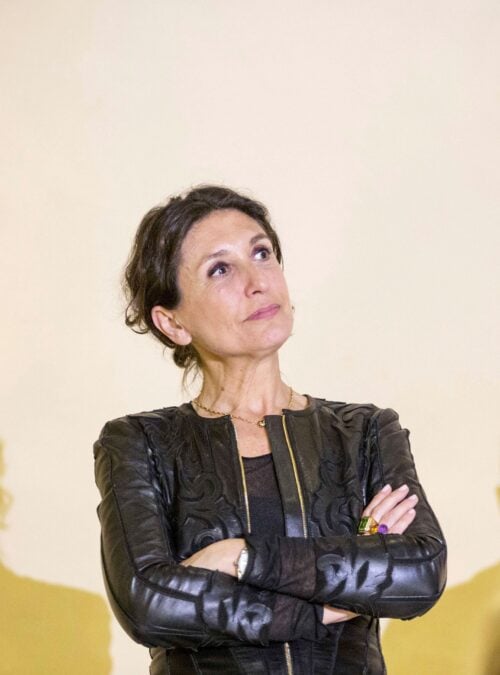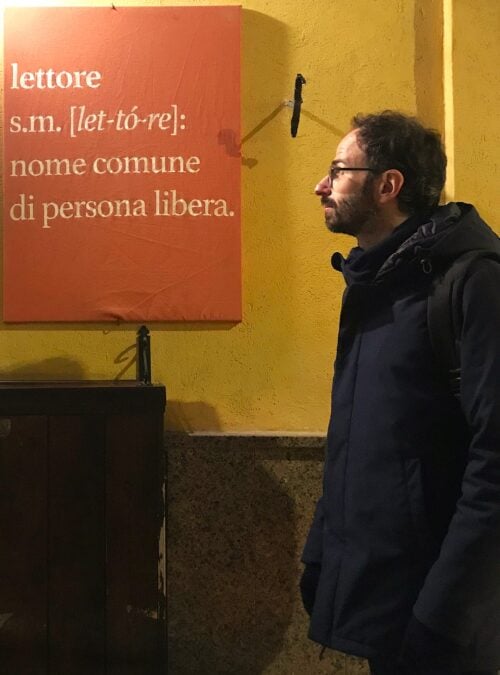Interview with Andrea Gentile (il Saggiatore)
Author: Paolo Grossi

An author and publishing director at il Saggiatore, Andrea Gentile’s books include L’impero familiare delle tenebre future (il Saggiatore, 2012), I vivi e i morti (minimum fax, 2018), Apparizioni (nottetempo, 2020) and Tramontare (minimum fax, 2021).
During the last few years, under your guidance, il Saggiatore has undergone an authentic metamorphosis. It has changed in both appearance and structure, becoming a publishing house whose image is now something new and “creative”. How did this happen and what strategical decisions were made to bring about this change? And what has been the reaction of readers?
When you create an identity you need to start with a very simple question: who are you, really? So the first step was to dig deep into the very soul of our publishing house. It wasn’t just a question of restyling, but of finding out exactly who we were. We also looked at our procedures, the way we worked and our vision of things.
I will try and summarise some of the steps:
– The cancelling of all our different collections to “invent the readers” of this publishing house. There were Saggiatore readers out there who did not know that that was what they were – readers most likely aged twenty to forty rather than fifty to seventy who would follow our publishing house not just because of the books in our catalogue, but because of everything we do in helping to create a very precise image – something contemporary and radical, at the same time both prestigious and courageous.
– The closing of the Tascabili (pocket books) collection, in the belief that for a catalogue like ours they were something outmoded for a variety of reasons. And not just that – this meant that the great classics in our catalogue now appeared alongside new writers, enabling us to say that a debut work of non-fiction or fiction had the same value as a work by Kerényi or de Beauvoir.
– The creating of new paradigms to plan book publishing – not yielding to the seductions of the moment, but working in terms of symbolic universes and emblems. Planning books with the idea that they would still be read a few decades, or at least a few years, later and planning them, in the case of Italian authors, with an international vision. Also abandoning a certain heterogeneity of styles among the various collections, aiming instead at a certain absoluteness – all books, even works of non-fiction, must be written in a literary way. At the same time, publishing books that would sometimes make people say: “only il Saggiatore could publish something like this”.
– The creation of a radical author policy. This means publishing voices (or authors) rather than books and ending a certain way of working in certain parts of the publishing sector,, which works more or less like this: I publish your book, check how it is selling, wait for you to propose a second book and then decide, also on the basis of book sales, whether or not to publish the book. We have instead created, where possible, an approach that is quite the opposite: the publisher is always the author’s interlocutor. This is not some romantic process – it is something that is also industrially sound. If I work for years on a book, I need to get the most out of what remains of that book, namely the author. Their voice. If I consider a book some autonomous product, I run the risk of investing a great deal of my time to achieve something that disappears after a few weeks, namely when the book is no longer present in bookshops.
– But also placing the publisher at the centre of everything. To create a very precise identity, a publisher needs to be a publisher and cannot compromise. An example: sometimes authors think that they should give their opinion about the cover of a book. Publishers, however, have not only all the professional competences needed to design the right cover for a book, they also have a very precise knowledge of their identity, which is being created all the time, as well as an enormous amount of information the author does not even have a clue about. This information comes from all the different interlocutors publishers must engage with in the book industry and they must take all of this information into consideration. An integral part of the identity of this Saggiatore, even though it is the most hidden, is this: the publisher is the custodian of an author’s poetics, but s/he must be allowed to do her/his job. Before authors sign a contract, they receive a long document entitled “The work of the publisher”, which outlines how we work, what a publisher does, why we know perfectly how, when and why to publish a certain book. It is a poetic act, but it is also an act of honesty.
– The attempt to create a workshop within the publishing house. Namely, betting on talented twenty-five-year-olds and throwing them into the mix in various, often quite diverse ways, so that they can get to know various facets of the job. It is a very demanding profession, but you are often rewarded for all your hard work.
– The consequences of the following principal: a publishing identity is not created merely through books, but also through every public or private initiative of everyone working for or with the publishing house. Starting from our basic identity, we have, therefore, studied everything we do as publishing actions, namely something that is planned. Even the envelopes we use to send books to journalists are “Saggiatore red” – something quite different from the standard yellow envelopes.
– The creating of a “business mentality”. It is not enough for a publishing house to invent and design, so everyone working for the publishing house is taught how to use numbers. A publishing proposal is never presented without a business plan – an idea can not only not be accepted without an accompanying document presenting all the numbers, it cannot even be looked at. The aim, in other words, is to have a publishing house of intellectuals, but with management skills.
The reaction of readers has so far been excellent. In the last seven years, il Saggiatore has increased its turnover by 175% and the number of books sold by 111%.
Your decision to stop organising books in collections would seem to deprive readers of a tool to help guide them through the mass of books in your catalogue. How have you got around this? What do you do to guide readers consulting the Saggiatore website through the catalogue?
The first users we had to assist in this revolution were booksellers. We have developed quite a lot of material over the years to show them how we work. Many people no longer even consider it a problem – they design their own “Saggiatore constellation”, where it doesn’t matter whether it’s fiction or non-fiction. This was one of the goals we wanted to achieve. On the website, readers can browse through the catalogue using tags, but I won’t hide from you that, given the hybrid nature of our texts, we often find ourselves in a rather embarrassing situation. To say, for example, that a book is an “economic” text is not so straightforward as it could also be read by people looking for history books because of some of its features. The truth is that il Saggiatore readers are now used to this constellation. They know that when we publish a book on algorithms, a book of poetry, an essay on capitalism and a two-thousand-page novel, we are creating one greater narrative.
Il Saggiatore has traditionally been identified as a publisher of non-fiction. Now, however, the catalogue also contains works of fiction, poetry, etc. Where do you intend to go in this direction? How much room will there be for Italian authors? Or authors writing their first books? And what communication choices have been made to render this literary dimension of the catalogue visible?
Currently, Italian authors account for almost 50% of our yearly production. The vast majority of Italian authors of both fiction and non-fiction have over the last few years been first-time authors – we have created a fleet of authors who have become part of an ecosystem. This ecosystem also includes a very new podcast platform (Voci) and a quite new online review (The Italian Review). The future of publishing will belong to people able to create neuronal connections between different types of content – not limiting the work of publishers to just books, but taking it into other worlds.
Our last question concerns the specific field in which newitalianbooks operates – the promotion of Italian books abroad. Which of the Italian works you have published over the last few years have aroused particular interest among international publishers?
This, too, is part of a very precise strategy. Having published many Italian books with an international idea and having notably increased the prestige of Italian books abroad, we have increased our sales abroad by 152% in the last four years. The bestselling books abroad include Breve storia della pasta by Luca Cesari, A spasso con i centenari by Daniela Mari, Ghiaccio by Marco Tedesco and Flores d’Arcais, and Hamburg by Marco Lupo.










